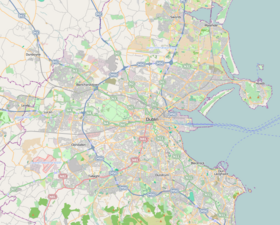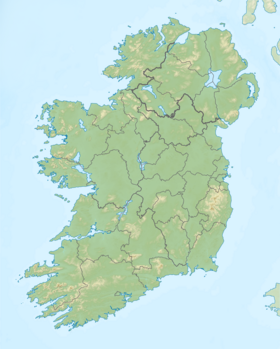| Montaña de tres rocas | |
|---|---|
| Binn Trí Charraig / Sliabh Ruadh | |
 Mástiles en Three Rock Mountain | |
| Punto mas alto | |
| Elevación | 448 m (1470 pies) [1] |
| Coordenadas | 53 ° 14′43 ″ N 6 ° 14′21 ″ W / 53.24528°N 6.23917°W Coordenadas: 53 ° 14′43 ″ N 6 ° 14′21 ″ W / 53.24528°N 6.23917°W [2] |
| Geografía | |
| Localización | Dún Laoghaire – Rathdown , Irlanda |
| Rango padre | Montañas de Dublín |
| Rejilla OSI / OSNI | O176231 |
| Mapa topográfico | Descubrimiento OSI No. 50 |
Three Rock Mountain ( irlandés : Binn Trí Charraig ; [3] arcaico : Sliabh Ruadh [4] ) es una montaña en Co Dublin, Irlanda. Tiene 444 metros (1.457 pies) de altura [1] y forma parte del grupo de colinas de las montañas de Dublín que comprende las montañas Two Rock , Three Rock, Kilmashogue y Tibradden . [5] La montaña toma su nombre de los tres grupos de rocas de granito en la cima. [6] Alguna vez se creyó que estas características eran creadas por el hombre: por ejemplo, Gabriel Berangerescribió de ellos en 1780, "Los tomo por altares sobre los que se ofrecían sacrificios […] la regularidad que se observa en amontonarlos me convence de que son obra del hombre, ya que no pudieron crecer en esa posición". [7] De hecho, los tres afloramientos son tors : características geológicas naturales producidas por el proceso gradual de meteorización . [6] Hoy en día, la cumbre está dominada por las numerosas torres y mástiles de radio que utilizan el sitio para transmitir sus señales a lo largo del área de Dublín que se encuentra debajo. [8] Las plantaciones forestales en las laderas consisten principalmente en abeto de Sitka , alerce japonés , pino silvestre , pino de Monterrey.y pino lodgepole . [1]
Acceso y recreación [ editar ]
Las vistas desde la cumbre son amplias y han atraído a visitantes durante muchos años. [9] El escritor Weston St. John Joyce describió la vista así: “La vista desde esta imponente altura, 1,479 pies sobre el nivel del mar, se extiende sobre una vasta extensión de montaña, mar y llanura, que comprende, al norte, el aguas azules de la bahía de Dublín , con Clontarf y Howth , las colinas de Naul o Man-of-War y las montañas de Mourne ; hacia el este, Kingstown , Dalkey y Killiney , y luego, sucesivamente, el fértil valle de Shanganagh, Carrickgollogan , Scalp , Bray Head, the Sugar Loaves, and the slopes of Prince William's Seat. In clear weather Holyhead and the Welsh mountains may frequently be discerned, Snowdon and the Llanberis Pass being usually the most conspicuous, but occasionally the elongated outline of Cader Idris may be observed some distance to the right".[10] By way of contrast, Gabriel Beranger said of Three Rock, "The extensive summit of this mountain, the parched ground and its solitude, make it the most awful spot I had ever seen".[7]
Access to the mountain is possible via the Coillte-owned forest recreation areas of Ticknock and Kilmashogue.[1] The route via Kilmashogue follows the Wicklow Way hiking trail for part of the way.[11] Three Rock is also traversed by the Dublin Mountains Way hiking trail that runs between Shankill and Tallaght.[2] In 2007 a concept was submitted to DLR Co Co to create a Cableway from Sandyford Luas to Three Rock and to open up the views to touristic and easier access.[12]
Several local sports clubs take their name from the mountain such as the Three Rock Orienteering Club has mapped the area and run orienteering competitions there since 1981[13] as well as Three Rock Rovers Hockey Club[14] (field hockey) and Three Rock Rovers association football club.[citation needed]
History[edit]
On the top of central tor at the summit are four bowl-shaped depressions: these are bullauns which were used in early Christian times for grinding.[15] At one time, to the east of central tor was the remains of an abandoned public house.[15]
Close to the summit is the ruins of an old army shooting range which closed in the 1970s.[16] The targets were raised and lowered by 12 men using levers in a concrete dugout.[17] A red flag was raised along the forest road to alert visitors that firing exercises were in progress.[17]
The remains of several hill forts, ring forts and other enclosures are to be found on the slopes of the mountain though they have largely disappeared under the forestry plantations.[18][19]
During the nineteenth century, much of the lower slopes of Three Rock were covered with small quarries, especially around the village of Barnacullia, which supplied paving stones for Dublin Corporation for many years.[20] Close to Barnacullia was a cottage that was occupied for many years by the Countess Markievicz up until the 1916 Easter Rising.[21] The children of James Connolly stayed at the cottage during the week of the Rising.[21] During the Irish War of Independence (1919–21) the 6th Battalion of the Dublin Brigade established a camp at Barnacullia.[22]
Further down the slopes, near the Ticknock Road, is a holy well, known as Grumley's Well, reputed to cure eye ailments.[23]
Transmission site[edit]
The main transmission site on Three Rock is owned and operated by 2RN a subsidiary of Irish national broadcaster RTÉ, its 140-metre (360') cable stayed mast is close to the peak, which is 448 metres (1470') above Ordnance Datum.
This site, and Cairn Hill in County Longford, were the first UHF television transmitters built by RTÉ to facilitate the introduction of their second television channel (RTÉ 2) in 1978. Both transmitters also helped improve television reception in their respective service areas. Since 1961 Dublin city had been served by the Kippure VHF television transmitter in County Wicklow which did not cover some Eastern and Southern parts of the city very satisfactorily. A low power VHF TV relay transmitter (now defunct) had broadcast from the links tower at the RTÉ campus in Donnybrook to serve most of the districts not reached by Kippure. The original transmission tower on the site was superseded by the present 140m mast in 2002, but the tower remains as a microwave link facility carrying service feeds for broadcast and telecomms.
Today the Three Rock transmitters provide the Irish digital television service, Saorview, to Dublin city and county,[24] as well as FM and DAB radio networks. Other masts at the site carry the majority of Dublin's local radio stations.
Current transmissions[edit]
Digital television[edit]
| Frequency | UHF | kW | Multiplex | Pol |
|---|---|---|---|---|
| 546 MHz | 30 | 125 | Saorview 1 | H |
| 570 MHz | 33 | 125 | Saorview 2 | H |
Digital radio[edit]
| Frequency | Block | kW | Multiplex |
|---|---|---|---|
| 227.360 MHz | 12C | 20 | DAB Ireland Mux 1 |
Analogue FM radio[edit]
| Frequency | kW | Service |
|---|---|---|
| 88.5 MHz | 5 | RTÉ Radio 1 |
| 90.7 MHz | 5 | RTÉ 2fm |
| 96.7 MHz | 5 | RTÉ lyric fm |
| 92.9 MHz | 5 | RTÉ Raidió na Gaeltachta |
| 94.9 MHz | 1.5 | Classic Hits 4FM[25] |
| 98.1 MHz | 5 | Dublin's 98FM |
| 100.3 MHz | 12.5 | Radio Nova 100 |
| 101.8 MHz | 0.5 | Today FM[26] |
| 102.2 MHz | 2 | Q102 |
| 103.2 MHz | 1 | Dublin City FM[27] |
| 103.8 MHz | 5 | SPIN 1038 |
| 104.4 MHz | 5 | FM104 |
| 106.0 MHz | 10 | Newstalk |
| 106.4 MHz | 0.5 | Raidió Na Life[28] |
| 106.8 MHz | 0.5 | Sunshine 106.8 |
Three Rock Digital TV relay transmitters[edit]
| Relay transmitter | County | Mux 1 | Mux 2 | kW | Pol |
|---|---|---|---|---|---|
| Greenore | Louth | 41 | 44 | 0.2 | V |
| Greystones | Wicklow | 42 | 45 | 0.5 | V |
References[edit]
- ^ a b c d "Ticknock". Coillte Outdoors. Retrieved 1 August 2010.
- ^ a b Discovery Series No. 50 (Map). Ordnance Survey Ireland.
- ^ "Three Rock Mountain". Placenames Database of Ireland. Department of Culture, Heritage and the Gaeltacht. Retrieved 6 June 2020.
- ^ "Three Rock Mountain – Archival Records" (jpg). Placenames Database of Ireland. Department of Culture, Heritage and the Gaeltacht. Retrieved 31 July 2010.
- ^ Healy, p. 105.
- ^ a b Joyce, p. 131.
- ^ a b Joyce, p. 132.
- ^ Pearson, p. 304-305.
- ^ Healy, p. 106.
- ^ Joyce, p. 133-134.
- ^ "Wicklow Way (Ticknock)". Coillte Outdoors. Retrieved 1 July 2010.
- ^ "[Infrastructural-Development-Sandyford-to-Three-Rock]".
- ^ "Three Rock Orienteering Club". Retrieved 1 August 2010.
- ^ "Three Rock Rovers Hockey Club". Retrieved 1 August 2010.
- ^ a b Healy, p. 109.
- ^ Dún Laoghaire–Rathdown County Council, p. 13.
- ^ a b Dún Laoghaire–Rathdown County Council, p. 12.
- ^ Healy, p. 108.
- ^ Healy, p. 112.
- ^ Pearson , p. 321.
- ^ a b Healy, p. 110.
- ^ Healy, p. 111.
- ^ Healy, p. 107.
- ^ UK Free TV. "Three Rock Transmitter". UK Free TV. Retrieved 6 November 2012.
- ^ http://www.bci.ie/documents/Final_Multi_City_Guide_April_07.doc
- ^ Replaced 100.3 MHz from RTÉ NL site
- ^ Previously 103.8 MHz
- ^ Previously 102.2 MHz
Bibliography[edit]
- Dún Laoghaire-Rathdown County Council (2009). Did You Know...? Forgotten Aspects of our Local Heritage. Dublin: Dun Laoghaire Rathdown County Council. ISBN 978-0-9557829-2-3.
- Healy, Patrick (April 2005). Rathfarnham Roads (pdf). Dublin: South Dublin Libraries. ISBN 0-9547660-3-2. Retrieved 7 August 2010.
- Joyce, Weston St. John (1994) [first published 1912]. The Neighbourhood of Dublin. Dublin: Hughes and Hughes. ISBN 0-7089-9999-9.
- Discovery Series No. 50: Dublin, Kildare, Meath, Wicklow (Map) (6th ed.). 1:50,000. Discovery Series. Ordnance Survey Ireland. 2010. ISBN 978-1-907122-17-0.
- Pearson, Peter (1998). Between the Mountains and the Sea. Dún Laoghaire–Rathdown County Council. Dublin: O'Brien Press. ISBN 0-86278-582-0.
External links[edit]
- Three Rock Mountain at Dublin Mountains Partnership
- Three Rock Mountain at Megalithomania
- [1] at [2]




